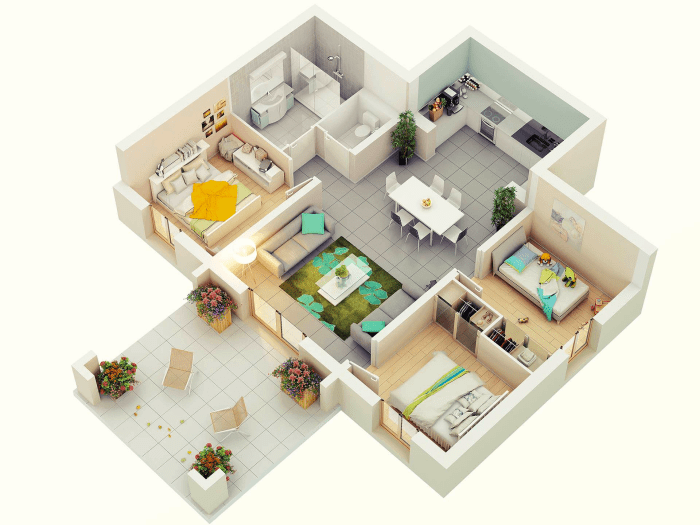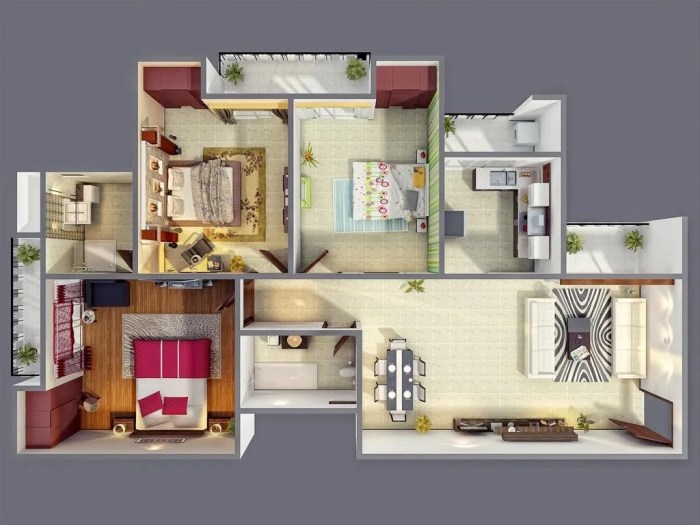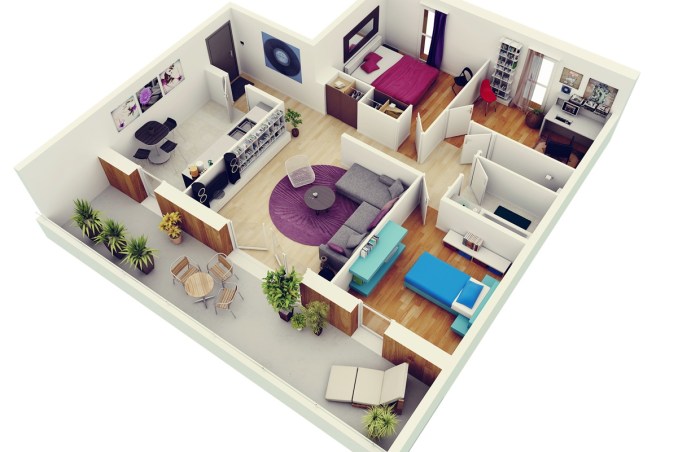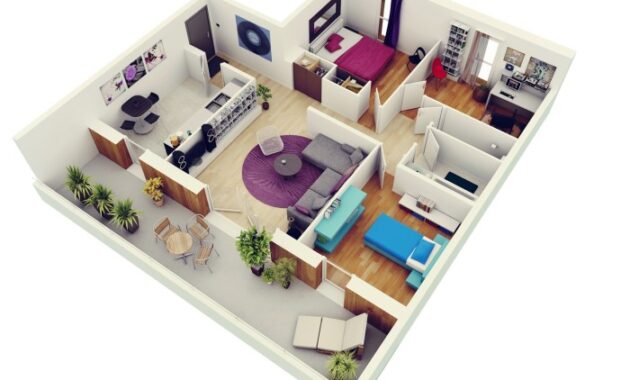3 Bedroom house interior design is an exciting endeavor, offering a canvas to transform a space into a haven of comfort and style. Whether you’re a seasoned homeowner or a first-time buyer, understanding the fundamentals of interior design is crucial for creating a home that reflects your personality and meets your family’s needs.
From layout considerations and color choices to furniture placement and décor accents, this guide explores the key elements of 3 bedroom house interior design, empowering you to craft a space that feels truly yours.
A well-designed 3 bedroom house seamlessly blends functionality and aesthetics, ensuring each area serves its purpose while reflecting your personal taste. This comprehensive guide delves into the art of creating a cohesive design, exploring everything from choosing a color palette and selecting furniture to maximizing space utilization and incorporating natural light.
Understanding the 3 Bedroom House Layout

A 3-bedroom house is a common choice for families and individuals seeking a comfortable and functional living space. The layout of a 3-bedroom house typically includes key areas designed to meet the needs of its occupants.
Typical Floor Plan, 3 bedroom house interior design
The typical floor plan of a 3-bedroom house generally includes a living room, dining room, kitchen, three bedrooms, and at least one or two bathrooms. The living room is often the central gathering space, while the dining room provides a dedicated area for meals.
The kitchen is typically located near the dining room for convenience. The bedrooms offer private spaces for sleeping and relaxation, while the bathrooms provide essential facilities.
Designing a 3 bedroom house can be exciting, allowing you to create distinct spaces for each room. If you’re drawn to a more historical aesthetic, consider incorporating elements of 1920s house interior design , which often featured elegant lines, rich colors, and statement pieces.
This can be achieved in a modern 3 bedroom house by using geometric patterns, luxurious fabrics, and antique-inspired furniture.
Variations in Layout
There are various variations in the layout of 3-bedroom houses, reflecting different design preferences and lifestyle needs. Some common variations include:
- Open-Concept Living Spaces: This design trend combines the living room, dining room, and kitchen into a single, open area, creating a sense of spaciousness and flow. This layout is popular for entertaining and family gatherings.
- Split-Level Designs: Split-level homes feature different levels connected by stairs, creating distinct areas for different functions. This layout can be particularly useful for maximizing space and separating living areas from bedrooms.
Examples of Different 3-Bedroom House Layouts
- Traditional Layout: This layout features separate rooms for each function, including a living room, dining room, kitchen, three bedrooms, and two bathrooms. This layout is ideal for families who value privacy and defined spaces.
Pros: Privacy, defined spaces, easy to furnish
Cons: Can feel cramped, less flexibility in layout
- Open-Concept Layout: This layout combines the living room, dining room, and kitchen into one large, open space. This layout is popular for families who enjoy entertaining and want a sense of spaciousness.
Pros: Spaciousness, great for entertaining, flexible layout
Cons: Less privacy, noise can carry throughout the space
- Split-Level Layout: This layout features different levels connected by stairs, creating distinct areas for different functions. For example, the living room and dining room could be on the main level, while the bedrooms are on a lower level. This layout can be particularly useful for maximizing space and separating living areas from bedrooms.
Pros: Maximizes space, separates living areas from bedrooms, creates distinct zones
Cons: Can be difficult to furnish, not ideal for families with young children
Designing for Functionality

A 3-bedroom house is a versatile space that can accommodate a variety of needs. To ensure that your home is not only beautiful but also functional and comfortable, it’s essential to prioritize the practical aspects of design. This involves considering the needs of the occupants, maximizing space utilization, and optimizing traffic flow.
Optimizing Traffic Flow
Traffic flow refers to the movement of people within a space. In a 3-bedroom house, it’s crucial to ensure that the flow is smooth and efficient to prevent congestion and promote a sense of spaciousness.
- Avoid Obstacles:Place furniture strategically to avoid creating bottlenecks or blocking walkways. Ensure that doorways are clear and that furniture is not positioned in a way that restricts movement.
- Define Pathways:Establish clear pathways throughout the house, leading to different areas like the kitchen, bedrooms, and living room. This can be achieved through the use of rugs, furniture arrangement, or architectural features.
- Consider Furniture Placement:Avoid placing furniture too close to walls, especially in high-traffic areas. Leave enough space for people to move around comfortably.
Decorating the Living Room: 3 Bedroom House Interior Design

The living room is the heart of your home, a space where you relax, entertain, and create memories. When designing a living room for a 3-bedroom house, the goal is to create a comfortable and inviting atmosphere that reflects your personal style while maximizing functionality.
Creating a Focal Point
A focal point is essential for a well-designed living room. It draws the eye and defines the space, providing a sense of balance and visual interest. The focal point could be a statement piece of furniture, a fireplace, a large piece of artwork, or even a window with a stunning view.
Designing a three-bedroom house can be a fun and challenging project. There are many styles to choose from, but if you’re looking for a timeless and elegant aesthetic, you might consider drawing inspiration from the 1900 house interior design era.
This period was known for its ornate details, rich colors, and luxurious textures, all of which can be incorporated into a modern three-bedroom home to create a truly unique and captivating space.
- A statement sofa with unique upholstery or a bold color can immediately create a focal point.
- A fireplace, whether traditional or modern, adds warmth and visual interest to the room.
- A large, dramatic artwork above the fireplace or sofa can serve as a focal point and showcase your personal style.
Furniture Placement
Furniture placement is crucial for maximizing functionality and creating a comfortable flow in the living room. Consider the size and shape of your room, the traffic patterns, and the purpose of each piece of furniture.
- Arrange seating in a conversational grouping, ensuring ample space for movement between pieces.
- Place a coffee table within easy reach of the seating area, providing a surface for drinks, snacks, and conversation.
- Consider adding a media console or entertainment center to house your television and other electronics.
Lighting
Lighting plays a significant role in setting the mood and atmosphere of the living room. A combination of ambient, task, and accent lighting is ideal for creating a balanced and functional space.
- Ambient lighting provides overall illumination, creating a warm and inviting atmosphere. Consider a ceiling fixture or a combination of floor and table lamps.
- Task lighting provides focused illumination for specific activities, such as reading or working. Desk lamps, sconces, or under-cabinet lighting are good options.
- Accent lighting highlights specific features, such as artwork, plants, or architectural details. Track lighting, spotlights, or string lights can be used for this purpose.
Incorporating Personal Touches and Artwork
Adding personal touches and artwork is the key to creating a unique and inviting living room. These elements reflect your personality, interests, and memories.
- Display family photos, travel souvenirs, or collections that hold special meaning to you.
- Choose artwork that complements your style and the overall color scheme of the room. Consider paintings, sculptures, photographs, or even tapestries.
- Incorporate decorative accessories, such as throws, pillows, rugs, and plants, to add warmth and personality to the space.
Optimizing Bathroom Design
Bathrooms are often considered the most personal spaces in a home, offering a sanctuary for relaxation and rejuvenation. Creating a bathroom that is both functional and stylish requires careful planning and consideration of various design elements. This section explores key aspects of bathroom design, including layout, storage solutions, fixtures, and decorative elements.
Bathroom Layout
The layout of a bathroom plays a crucial role in its functionality and overall aesthetic appeal. Different layouts cater to different needs and preferences, and it’s essential to choose a layout that optimizes space utilization and creates a comfortable flow.
- Single-Vanity Layout:This layout is common in smaller bathrooms, featuring a single vanity, toilet, and shower or tub. It’s a simple and efficient design that maximizes space.
- Double-Vanity Layout:Ideal for larger bathrooms, this layout provides separate vanities for two individuals, enhancing privacy and convenience.
- Walk-In Shower Layout:This layout eliminates a bathtub, creating a spacious and accessible shower area, perfect for those seeking a minimalist and functional design.
- Separate Shower and Tub Layout:This layout provides both a shower and a bathtub, offering versatility and accommodating different needs.
The choice of layout depends on factors such as bathroom size, the number of users, and personal preferences.
Storage Solutions
Efficient storage is essential in any bathroom to keep toiletries, towels, and other items organized. There are various storage solutions available, each with its own advantages:
- Cabinets:Wall-mounted or freestanding cabinets provide ample storage space for toiletries, towels, and other items. They can be customized to fit the specific needs of the bathroom.
- Drawers:Vanity drawers offer convenient storage for smaller items, keeping them easily accessible and organized.
- Shelves:Open shelves provide easy access to frequently used items, but they may require more regular tidying.
- Medicine Cabinets:Wall-mounted medicine cabinets offer secure storage for medications and personal care items, keeping them out of sight.
When selecting storage solutions, consider the size and layout of the bathroom, as well as the individual needs and preferences of the users.
Fixtures
Bathroom fixtures play a crucial role in functionality and style. Selecting high-quality fixtures that complement the overall design is essential.
- Toilets:Toilets are available in various styles, from traditional to modern. Consider factors such as water efficiency, flushing power, and seat height when making a selection.
- Sinks:Sinks come in various sizes, shapes, and materials. Consider the size of the vanity and the overall design aesthetic when choosing a sink.
- Showers:Showerheads can be fixed, handheld, or rain shower style. Consider water pressure, spray patterns, and temperature control when selecting a showerhead.
- Bathtubs:Bathtubs are available in various sizes, shapes, and materials. Consider the space available and the desired style when choosing a bathtub.
Fixtures should be chosen based on their functionality, durability, and aesthetic appeal, ensuring they complement the overall design of the bathroom.
Decorative Elements
Decorative elements can transform a bathroom from ordinary to extraordinary. Tiles, vanities, and lighting are key elements that contribute to the overall style and ambience of the bathroom.
Designing a three-bedroom house involves a lot of considerations, from maximizing space to creating a cohesive flow. When dealing with a smaller footprint, like a 120 sq yards house interior design , you’ll need to be extra strategic. This means prioritizing functionality, incorporating smart storage solutions, and selecting furniture that serves multiple purposes.
With careful planning, even a compact three-bedroom home can be both stylish and comfortable.
- Tiles:Tiles are a versatile and durable material for bathroom walls and floors. They come in various colors, patterns, and textures, offering endless possibilities for creating unique designs.
- Vanities:Vanities are a focal point in the bathroom, providing storage and a stylish element. They come in various materials, such as wood, stone, and laminate, offering a range of styles and finishes.
- Lighting:Lighting plays a crucial role in creating the desired ambience in a bathroom. Consider using a combination of ambient, task, and accent lighting to create a functional and inviting space.
By carefully selecting and incorporating decorative elements, you can create a bathroom that reflects your personal style and enhances the overall ambience of the space.
Incorporating Natural Light
Natural light is an essential element in interior design, contributing to a sense of spaciousness, warmth, and well-being. It can enhance the overall ambiance of your home and make it feel more inviting and comfortable.Maximizing natural light in a 3-bedroom house involves strategically utilizing windows, skylights, and mirrors to create a bright and airy atmosphere.
Utilizing Windows for Optimal Light
Windows are the primary source of natural light in a house. To maximize their potential, consider the following:
- Choose large windows, particularly in living areas, to allow ample sunlight to enter.
- Ensure windows are positioned to capture sunlight throughout the day, considering the direction of the sun’s path.
- Use light-colored window treatments, such as sheer curtains or blinds, to allow maximum light penetration while maintaining privacy.
Maximizing Light with Skylights
Skylights are an excellent way to introduce natural light into rooms that may lack sufficient window space, especially in bedrooms or bathrooms.
- Skylights can be installed in various sizes and shapes, depending on the room’s size and design.
- Consider the direction of the skylight to avoid excessive glare, particularly in rooms with sensitive electronics.
- Use a light-diffusing material on the skylight to soften the light and prevent it from being too harsh.
Enhancing Light with Mirrors
Mirrors are a simple and effective way to reflect light and create the illusion of a larger and brighter space.
- Place mirrors strategically to bounce light from windows or skylights into darker areas.
- Use large mirrors in hallways or entryways to reflect light and make the space feel more open.
- Consider using mirrored furniture or decorative accents to enhance the reflective effect.
Using Light to Enhance Ambiance
Light plays a crucial role in setting the mood and ambiance of different rooms.
- In living rooms, soft, warm lighting can create a cozy and inviting atmosphere. Use lamps, candles, or dimmable overhead lights to achieve this effect.
- Bedrooms should have a calming and relaxing atmosphere. Use soft lighting, such as bedside lamps or dimmable overhead lights, to promote sleep.
- Bathrooms can benefit from bright, natural light. Use windows or skylights to illuminate the space, and consider installing task lighting for makeup application or shaving.
Last Point
By understanding the principles of 3 bedroom house interior design, you can transform your house into a home that is not only visually appealing but also functional and comfortable. From maximizing natural light to creating a cohesive style, every decision you make contributes to the overall ambiance of your space.
Remember, the key to successful interior design lies in creating a space that reflects your unique personality and meets your family’s needs, making it a sanctuary you truly love.
Question & Answer Hub
What are some popular interior design styles for a 3 bedroom house?
Popular styles include contemporary, minimalist, traditional, farmhouse, and eclectic. Choosing a style that aligns with your personal preferences and the overall architecture of your house is essential.
How can I make my 3 bedroom house feel more spacious?
Using light colors, incorporating mirrors, and maximizing natural light can create a sense of spaciousness. Opting for multi-functional furniture and keeping clutter at bay also contributes to a more open feel.
What are some tips for choosing a color palette for my 3 bedroom house?
Consider the overall style of your house, the amount of natural light, and your personal preferences. Start with a neutral base and add pops of color through accents and décor. Remember to consider the impact of color on mood and atmosphere.

